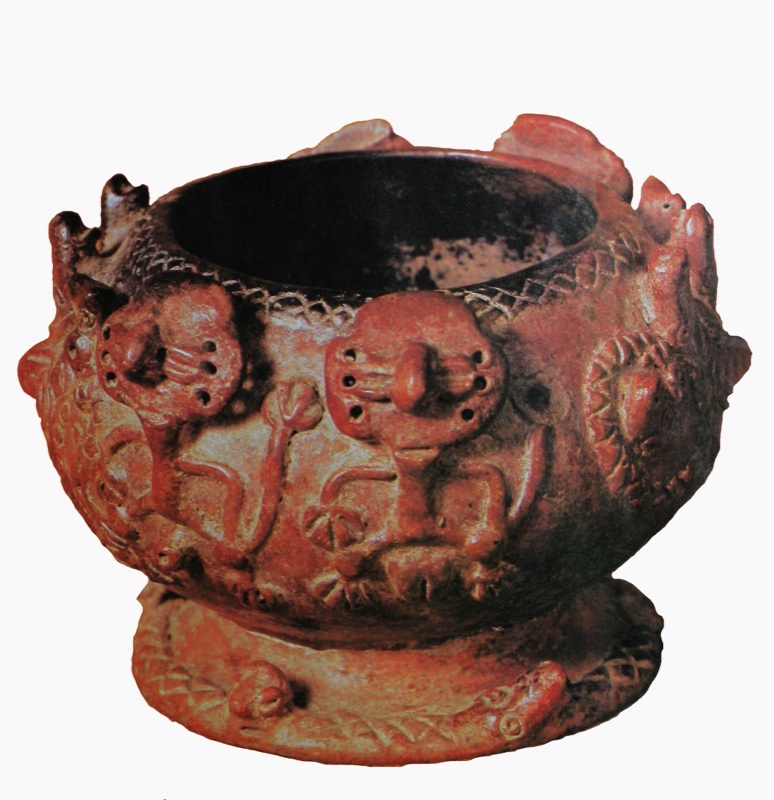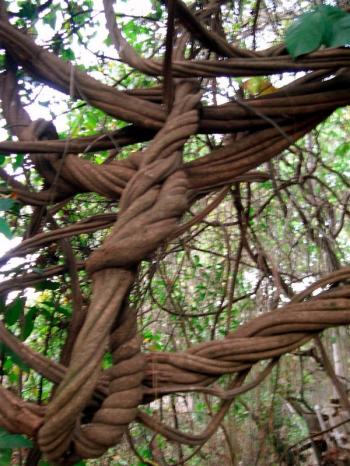
Ayahuasca
Sinchi sinchi medicina — 'too much medicine'— the elders sang.
Synonyms: Boa Ayahuasca, Caupuri Ayahuasca, Yellow Ayahuasca, Caapi, Yagé, Yaje, Yahe, Yaxe, Hoasca, Vine of the Soul, Bejuco de Oro, Biaxa, Dápa, Doctor, Kaapi, Kahí, Maridi, Mihi, Natema, Nepe, Pindé, Totenliane, Vine of the Dead, Netma, Yage, caapi, nixi honi xuma, hoasca, vegetal, kahi, natema, pinde, dapa, mihi, vinho da alma, professor dos professores, pequena morte.
Associated Animal Spirit: Snake
There are many types of Yagé:
Tigre
Cielo
Miel de Yagé
Agua
Loro
Agua
Cosimento
Etc.
Tigre
Cielo
Miel de Yagé
Agua
Loro
Agua
Cosimento
Etc.
Ayahuasca, known by various names by different indigenous groups in South America, is a generic term commonly associated with preparations of the mildly psychoactive vine Banisteriopsis caapi. Ayahuasca literally translates from the Quechua language of the North Andes as “soul vine” or “vine of the dead” (“aya”, meaning “soul” or“spirit”, and “huasca” meaning “vine”) and has traditionally been consumed by indigenous communities such as the Aruák, Chocó, Jívaro, Pano, and Tukano across the upper reaches of the Amazon River system in Bolivia, Brazil, Colombia, Ecuador, and Peru.
Beyond the indigenous communities of the Upper Amazon Basin, ayahuasca is most popularly consumed in two kinds of ritual practices. The first is within the Brazilian “ayahuasca religions” of Barquinha, Santo Daime and A União do Vegetal. These religions have many of the formal attributes associated with mainstream traditional religions such as Christianity, Islam and Judaism – for example the inclusion of prayers, songs and ritual disciplines.
Used for thousands of years by medicine men across much of the South American rainforest, ayahuasca is considered the cornerstone of many (if not most) Amazon healing methods. Viewed within indigenous folklore as “the mother of all plants,” the potent herbal mixture is actually a combination of elements. Its main ingredient is the Banisteriopsis caapi vine, which contains several powerful MAO (monoamine oxidase) inhibitors. When combined with any of several other plants rich in the psychedelic compound DMT (most commonly the shrub Psychotria viridis, commonly known as chakruna) and boiled as part of a ceremonious preparation ritual, the vine creates an extremely potent psychoactive brew with a vast array of applications in the canon of South American shamanic remedies.
The preparation of this mystical plant brew suggests a riddle in itself: the plants typically used to prepare ayahuasca are native to virtually opposite ends of the jungle, hundreds of miles apart, and anthropologists are still bafed as to how these ancient and seemingly primitive tribes had the insight and botanical knowledge to locate, identify, and prepare them to create something so precise and powerful. There are several legends told among the tribes regarding this mystery. One of the legends speaks of an old king who lived in the rainforest, bringing great healing and wisdom to his people. When his time came to die, he told them that upon his burial, two plants would sprout from his tomb, and if cooked together, they would reveal the same healing and wisdom that he offered throughout his lifetime. Unfathomable as this legend may seem, the true origin of ayahuasca remains just as mysterious to this day.
In its most common form, ayahuasca is a strong smelling brown liquid with a bitter taste. In addition to the age, quality, and type of plants used, the psychoactive potency of ayahuasca differs relative to the environmental conditions in which they are grown, the ratio of their combination and the amount of processing they undergo. The size of dose and frequency of consumption varies from one ritual context to another. Depending upon individual physiology, ayahuasca begins to make itself felt 20 or 30 minutes after first being consumed, with subsequent doses increasing its psychotropic effects.
A dose of ayahuasca can range from a teaspoon to several cups, depending on the weight, age, physical fitness, and overall experience of the patient. The mixture has an extremely bitter taste, and given the high alkalinity of its compounds, acts as a powerful cleansing agent in many respects. As the body digests and ab- sorbs the brew, it can often cause a very thorough purging of the digestive system, either through diarrhea or intense, frequent vomiting spells. However, there are many instances in which a patient will not purge at all. Perhaps the brew’s best-known property is its ability to induce sustained, lucid, dream-like psychedelic visions. The intensity of these visions can range from mild to extremely powerful and disorienting, but each ayahuasca dose produces a different effect, and each participant experiences his or her own unique results.
The brew is meant to be consumed as part of a highly sacred and secretive ceremony, led by one or several experienced curandero. Each patient must spend the preceding day preparing for this event, both in their diet and their mental and spiritual state. These rituals can involve anywhere from a single patient to a large group of twenty or more, depending on the circumstances, and are typically conducted at night inside of a simple enclosure known as a maloka. Each curandero employs their own unique elements to the ceremonies they oversee, which can include group sharing and interaction, icaros (or spiritual songs), and individual visits.
Beyond the indigenous communities of the Upper Amazon Basin, ayahuasca is most popularly consumed in two kinds of ritual practices. The first is within the Brazilian “ayahuasca religions” of Barquinha, Santo Daime and A União do Vegetal. These religions have many of the formal attributes associated with mainstream traditional religions such as Christianity, Islam and Judaism – for example the inclusion of prayers, songs and ritual disciplines.
Used for thousands of years by medicine men across much of the South American rainforest, ayahuasca is considered the cornerstone of many (if not most) Amazon healing methods. Viewed within indigenous folklore as “the mother of all plants,” the potent herbal mixture is actually a combination of elements. Its main ingredient is the Banisteriopsis caapi vine, which contains several powerful MAO (monoamine oxidase) inhibitors. When combined with any of several other plants rich in the psychedelic compound DMT (most commonly the shrub Psychotria viridis, commonly known as chakruna) and boiled as part of a ceremonious preparation ritual, the vine creates an extremely potent psychoactive brew with a vast array of applications in the canon of South American shamanic remedies.
The preparation of this mystical plant brew suggests a riddle in itself: the plants typically used to prepare ayahuasca are native to virtually opposite ends of the jungle, hundreds of miles apart, and anthropologists are still bafed as to how these ancient and seemingly primitive tribes had the insight and botanical knowledge to locate, identify, and prepare them to create something so precise and powerful. There are several legends told among the tribes regarding this mystery. One of the legends speaks of an old king who lived in the rainforest, bringing great healing and wisdom to his people. When his time came to die, he told them that upon his burial, two plants would sprout from his tomb, and if cooked together, they would reveal the same healing and wisdom that he offered throughout his lifetime. Unfathomable as this legend may seem, the true origin of ayahuasca remains just as mysterious to this day.
In its most common form, ayahuasca is a strong smelling brown liquid with a bitter taste. In addition to the age, quality, and type of plants used, the psychoactive potency of ayahuasca differs relative to the environmental conditions in which they are grown, the ratio of their combination and the amount of processing they undergo. The size of dose and frequency of consumption varies from one ritual context to another. Depending upon individual physiology, ayahuasca begins to make itself felt 20 or 30 minutes after first being consumed, with subsequent doses increasing its psychotropic effects.
A dose of ayahuasca can range from a teaspoon to several cups, depending on the weight, age, physical fitness, and overall experience of the patient. The mixture has an extremely bitter taste, and given the high alkalinity of its compounds, acts as a powerful cleansing agent in many respects. As the body digests and ab- sorbs the brew, it can often cause a very thorough purging of the digestive system, either through diarrhea or intense, frequent vomiting spells. However, there are many instances in which a patient will not purge at all. Perhaps the brew’s best-known property is its ability to induce sustained, lucid, dream-like psychedelic visions. The intensity of these visions can range from mild to extremely powerful and disorienting, but each ayahuasca dose produces a different effect, and each participant experiences his or her own unique results.
The brew is meant to be consumed as part of a highly sacred and secretive ceremony, led by one or several experienced curandero. Each patient must spend the preceding day preparing for this event, both in their diet and their mental and spiritual state. These rituals can involve anywhere from a single patient to a large group of twenty or more, depending on the circumstances, and are typically conducted at night inside of a simple enclosure known as a maloka. Each curandero employs their own unique elements to the ceremonies they oversee, which can include group sharing and interaction, icaros (or spiritual songs), and individual visits.


Why?
Many ayahuasca tourists today drink the sacred brew themselves in order to be transported to spiritual realms, experiencing psychedelic journeys not unlike those brought on by peyote, LSD or psilocybin mushrooms. The psychoactive ingredient in the brew is dimethyltryptamine (DMT) — a chemical that occurs naturally in the brain and is associated with dreaming and the visions that accompany near-death experiences (NDEs). (DMT is present in all plants and animals.) Because of this divinatory potential, ayahuasca is classed as a plant entheogen (i.e., substance that allows discovery of God within).
The term “ayahuasca” is used casually to denote both the final brew and the vine that it contains. The brew is made from the Banisteriopsis caapi vine, usually in combination with another plant such as chacruna (Psychotria viridis). While experts debate details of the chemistry, essentially the chacruna (or similar plant) is the main DMT source with the Banisteriopsis caapi acting as a monoamine oxidase inhibitor (MAOI) — in other words, ayahuasca allows DMT to enter the bloodstream without being destroyed by stomach chemicals, as would otherwise occur.
“Is ayahuasca right for ME?” The truth is, no one can tell you if ayahuasca is the right path for you, you have to use your intuition and trust yourself.

Jagubes flowering in Céu do Hawaii. They usually flower in Jan-February here in the islands, while in Brasil they usually flower in July-August.

